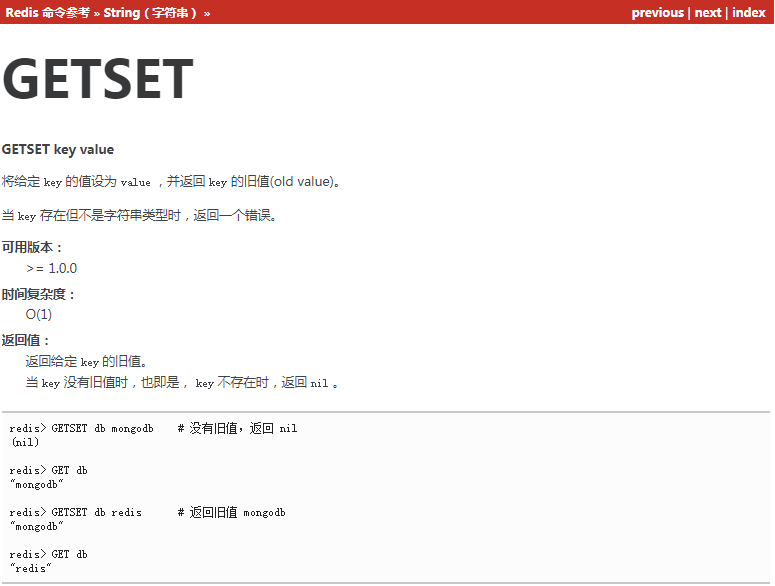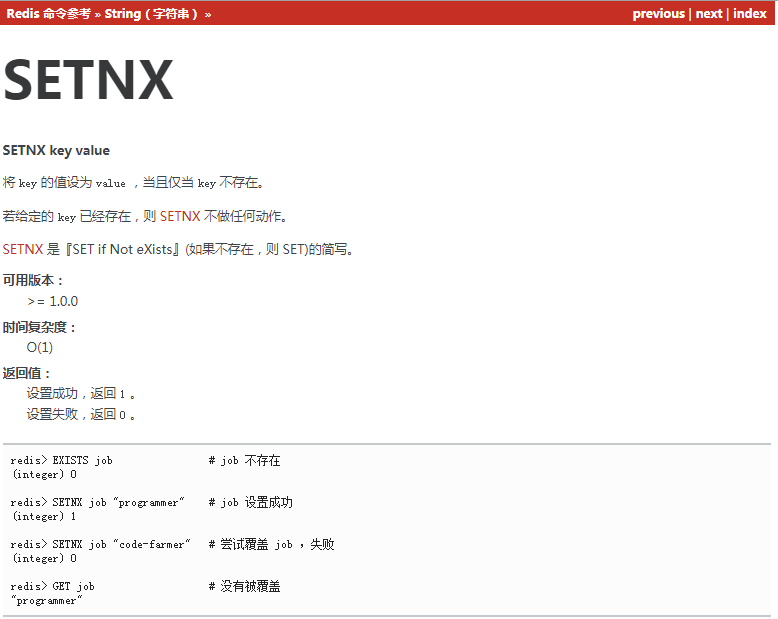Redis分布式锁的应用
- 有些场景需要加锁处理,比如:秒杀,全局递增ID,楼层生成等等。大部分的解决方案是基于DB实现的,Redis为单进程单线程模式,采用队列模式将并发访问变成串行访问,且多客户端对Redis的连接并不存在竞争关系。其次Redis提供一些命令SETNX,GETSET,可以方便实现分布式锁机制。
GETSET方式

http://doc.redisfans.com/string/getset.html
public final class RedisLockUtil {
private static final int defaultExpire = 60;
/**
* 加锁
* @param key redis key
* @param expire 过期时间,单位秒
* @return true:加锁成功,false,加锁失败
*/
public static boolean lock(String key, int expire) {
RedisService redisService = SpringUtils.getBean(RedisService.class);
long status = redisService.setnx(key, "1");
//如果状态等于一 则 成功 返回值成功
if(status == 1) {
redisService.expire(key, expire);
return true;
}
//否则设置失败
return false;
}
public static boolean lock(String key) {
return lock2(key, defaultExpire);
}
/**
* 加锁
* @param key redis key
* @param expire 过期时间,单位秒
* @return true:加锁成功,false,加锁失败
*/
public static boolean lock2(String key, int expire) {
RedisService redisService = SpringUtils.getBean(RedisService.class);
long value = System.currentTimeMillis() + expire;//当时时间加过期时间
long status = redisService.setnx(key, String.valueOf(value));//尝试存一下
if(status == 1) {
//如果可以直接存进去就 成功了 获取了锁
return true;
}
//如果没有设置成功 的后获取锁的value
long oldExpireTime = Long.parseLong(redisService.get(key, "0"));
if(oldExpireTime < System.currentTimeMillis()) {
//超时
long newExpireTime = System.currentTimeMillis() + expire;
//用getset覆盖 (getset理解为先get,再set。get的是旧的值,set的是新的值。)
long currentExpireTime = Long.parseLong(redisService.getSet(key, String.valueOf(newExpireTime)));
if(currentExpireTime == oldExpireTime) {
return true;
}
}
return false;
}
public static void unLock1(String key) {
RedisService redisService = SpringUtils.getBean(RedisService.class);
redisService.del(key);
}
public static void unLock2(String key) {
RedisService redisService = SpringUtils.getBean(RedisService.class);
long oldExpireTime = Long.parseLong(redisService.get(key, "0"));
//oldExpireTime = 原当前时间 + 过期时间 其实不大于当前时间 都已经过期了
if(oldExpireTime > System.currentTimeMillis()) {
redisService.del(key);
}
}
}
在实际使用总大多是注解,获取切面实现。
SETNX方式

http://redisdoc.com/string/setnx.html
以下是http://blog.csdn.net/u010359884/article/details/50310387 实现方式,经过使用和一些业务改造。
public class CacheLockInterceptor implements InvocationHandler{
public static int ERROR_COUNT = 0;
private Object proxied;
public CacheLockInterceptor(Object proxied) {
this.proxied = proxied;
}
@Override
public Object invoke(Object proxy, Method method, Object[] args) throws Throwable {
CacheLock cacheLock = method.getAnnotation(CacheLock.class);
//没有cacheLock注解,pass
if(null == cacheLock){
System.out.println("no cacheLock annotation");
return method.invoke(proxied, args);
}
//获得方法中参数的注解
Annotation[][] annotations = method.getParameterAnnotations();
//根据获取到的参数注解和参数列表获得加锁的参数
Object lockedObject = getLockedObject(annotations,args);
String objectValue = lockedObject.toString();
//新建一个锁
RedisLock lock = new RedisLock(cacheLock.lockedPrefix(), objectValue);
//加锁
boolean result = lock.lock(cacheLock.timeOut(), cacheLock.expireTime());
if(!result){//取锁失败
ERROR_COUNT += 1;
throw new CacheLockException("get lock fail");
}
try{
//加锁成功,执行方法
return method.invoke(proxied, args);
}finally{
lock.unlock();//释放锁
}
}
/**
*
* @param annotations
* @param args
* @return
* @throws CacheLockException
*/
private Object getLockedObject(Annotation[][] annotations,Object[] args) throws CacheLockException{
if(null == args || args.length == 0){
throw new CacheLockException("方法参数为空,没有被锁定的对象");
}
if(null == annotations || annotations.length == 0){
throw new CacheLockException("没有被注解的参数");
}
//不支持多个参数加锁,只支持第一个注解为lockedObject或者lockedComplexObject的参数
int index = -1;//标记参数的位置指针
for(int i = 0;i < annotations.length;i++){
for(int j = 0;j < annotations[i].length;j++){
if(annotations[i][j] instanceof LockedComplexObject){//注解为LockedComplexObject
index = i;
try {
return args[i].getClass().getField(((LockedComplexObject)annotations[i][j]).field());
} catch (NoSuchFieldException | SecurityException e) {
throw new CacheLockException("注解对象中没有该属性" + ((LockedComplexObject)annotations[i][j]).field());
}
}
if(annotations[i][j] instanceof LockedObject){
index = i;
break;
}
}
//找到第一个后直接break,不支持多参数加锁
if(index != -1){
break;
}
}
if(index == -1){
throw new CacheLockException("请指定被锁定参数");
}
return args[index];
}
}
/**
* 加锁
* 使用方式为:
* lock();
* try{
* executeMethod();
* }finally{
* unlock();
* }
* @param timeout timeout的时间范围内轮询锁
* @param expire 设置锁超时时间
* @return 成功 or 失败
*/
public boolean lock(long timeout,int expire){
long nanoTime = System.nanoTime();
timeout *= MILLI_NANO_TIME;
try {
//在timeout的时间范围内不断轮询锁
while (System.nanoTime() - nanoTime < timeout) {
//锁不存在的话,设置锁并设置锁过期时间,即加锁
if (this.redisClient.setnx(this.key, LOCKED) == 1) {
this.redisClient.expire(key, expire);//设置锁过期时间是为了在没有释放
//锁的情况下锁过期后消失,不会造成永久阻塞
this.lock = true;
return this.lock;
}
System.out.println("出现锁等待");
//短暂休眠,避免可能的活锁
Thread.sleep(3, RANDOM.nextInt(30));
}
} catch (Exception e) {
throw new RuntimeException("locking error",e);
}
return false;
}
public void unlock() {
try {
if(this.lock){
redisClient.delKey(key);//直接删除
}
} catch (Throwable e) {
}
}这也是大家常用的方式,但是这种方式的实现存在锁过期释放时,被正确释放。推荐GETSET。
https://www.cnblogs.com/yjf512/archive/2017/03/22/6597814.html
http://blog.csdn.net/u010648555/article/details/70139541
如果长时间获取不到,就会获取锁失败,相当于没加锁!
这里还有可能发生其他问题:
(1)并发情况,expire主动释放锁的时候,可能释放的是别人的锁;
比如,这个锁我上了10s,但是我处理的时间比10s更长,到了10s,这个锁自动过期了,被别人取走了,并且对它重新上锁了。那么这个时候,我再调用Redis::del就是删除别人建立的锁了。
(2)Redis服务挂掉,锁失败,相当于没加锁!最好使用主从+哨兵提高 高可用。集群。
Redis实现分布式锁全局锁—Redis客户端Redisson中分布式锁RLock实现
https://my.oschina.net/haogrgr/blog/469439
来源:oschina
链接:https://my.oschina.net/u/3418748/blog/1541178